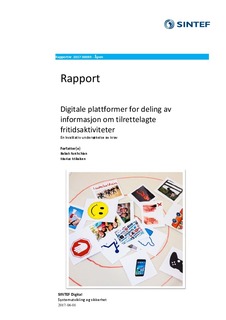| dc.contributor.author | Farshchian, Babak A. | |
| dc.contributor.author | Mikalsen, Marius | |
| dc.date.accessioned | 2017-06-06T07:19:30Z | |
| dc.date.available | 2017-06-06T07:19:30Z | |
| dc.date.created | 2017-06-02T13:38:36Z | |
| dc.date.issued | 2017 | |
| dc.identifier.isbn | 978-82-14-06721-7 | |
| dc.identifier.issn | 1504-9795 | |
| dc.identifier.uri | http://hdl.handle.net/11250/2444366 | |
| dc.description.abstract | Prosjektet Ung IT handler om digitale løsninger som kan øke deltakelse i fritidsaktiviteter for barn og unge med nedsatt funksjonsevne. Prosjektet ser spesielt på mulighetene til en selvorganiserende digital plattform for formidling av informasjon om fritidsaktiviteter. Forskning viser at dårlig tilgang og kvaliteten på slik informasjon er viktige årsaker til at barn og unge ikke deltar i fritidsaktiviteter. Prosjektet har gjennomført flere intervjuer og workshoper med både familier, kommuneansatte og arrangører av fritidsaktiviteter. Vi har belyst informasjonsbehovet. Vi har også sett på hva selvorganisering betyr, hvorfor det er viktig i denne sammenhengen, og hvordan man kan lage en selvorganiserende digital plattform for denne gruppen. Oppdragsgiver: Trondheim kommune | nb_NO |
| dc.description.abstract | The goal of the project Ung IT at the municipality of Trondheim, Norway, is to elicit requirements for a self-organising digital platform to share information about leisure activities for children and young people with disabilities. A new platform is intended to be developed in a follow-up project, with the goal to increase the participation of the target group in leisure activities. The motivation for this project is the perceived lack of high quality information about leisure activities in the region. We don't have enough knowledge about the role such information plays for the families, and what children, young people and parents want in such information. Our findings show that access to information about leisure activities is highly sought after among the interviewed families.
In our study we have interviewed a number of stakeholders, including children and young people, their parents, employees at the municipality, organisers of leisure activities, and IT vendors. Through interviews and workshops we have shed light on how families search for, find and use information about leisure activities they want to participate to, what they think about the quality of such information, what challenges they meet, and how they think digital solutions can improve the situation. We have also investigated the challenges that the municipality and organisers have related to producing good quality information, and making this information available. Our findings show that there is a lack of high quality and relevant information about leisure activities, and that this lack of information creates barriers to participation. Our findings also show that it is difficult for organisers to produce and make this information available. More specifically, our findings show that:
• Descriptions of leisure activities often lack information about what kind of disabilities are accommodated for and who the intended user group is.
• Information about adaptation to specific disabilities is not standardised and difficult to search for.
• Children and young people with disabilities have very different requirements for adaptation. This makes it difficult for organisers to describe all possible adaptation scenarios.
• Families have suboptimal experiences related to participation in leisure activities because of a mismatch between available information about the activity, and the actual adaptation exercised during the activity.
• Activity organisers often lack incentives, tools and resources needed to make high quality information about their activities available online.
• Information about activities is often shared through informal channels. This can exclude families who don't have an extensive network of friends.
In order to develop a digital platform, Trondheim municipality should:
• Have an initial dialog with the stakeholders involved to create a strategy for ownership and operational aspects of a platform.
• Choose a technical solution that supports distribution of information and its maintenance. Information about leisure activities is highly distributed and should not be centralised. Automatic collection of information, and mechanisms from social media and crowdsourcing can be used.
• A strong incentive model should be in place to motivate organisers to make quality information available online. Children and parents should be able to augment this information.
• The platform should be co-designed with the families and the organisers so that it can provide them with an easy-to-use interface. | nb_NO |
| dc.language.iso | mis | nb_NO |
| dc.publisher | SINTEF | nb_NO |
| dc.relation.ispartof | SINTEF Rapport | |
| dc.relation.ispartofseries | SINTEF Rapport; | |
| dc.rights | Attribution-NonCommercial-NoDerivatives 4.0 Internasjonal | * |
| dc.rights.uri | http://creativecommons.org/licenses/by-nc-nd/4.0/deed.no | * |
| dc.title | Digitale plattformer for deling av informasjon om tilrettelagte fritidsaktiviteter | nb_NO |
| dc.title.alternative | Digital platforms for sharing of information about leisure activities for children and young people with disabilities –A qualitative study of requirements. | nb_NO |
| dc.type | Research report | nb_NO |
| dc.source.pagenumber | 32 + vedlegg | nb_NO |
| dc.source.issue | 2017:00093 | nb_NO |
| dc.identifier.cristin | 1473767 | |
| dc.relation.project | Stiftelsen SINTEF: 102014575 | nb_NO |
| cristin.unitcode | 7401,90,13,0 | |
| cristin.unitname | Systemutvikling og sikkerhet | |
| cristin.ispublished | true | |
| cristin.fulltext | original | |

